[left side]
Eugenics
Looking over these pedigrees one is impressed by the fact, first, that the incidence of diseases is not haphazard nor, in any large family, do the various causes of death occur in the proportions given in the census tables for the population as a whole. Tuberculosis of the lungs is the cause of more than 10 percent of the deaths in the United States but it would not be difficult to pick out of my collection ten families comprising about 100 deceased persons among whom, instead of the expected 10 not one died of consumption. Similarly there are many families in which no nervous disease has occurred in three generations; others without kidney diseases and so on. On the other hand, in other families 40 to 50 percent or even 80 percent are attacked by lung and throat troubles or nervous defects. These differences cannot be attributed chiefly to environment, because the occur in families of which the members are widely dispersed and have varied occupations. They indicate fundamental differences in the protoplasm.
But, it may properly be urged, how about environment? Are not many of these examples of
20
[right side]
Fit and Unfit Matings
occurrence of disease in one family due to infection or to similar untoward conditions? I do not doubt that they [italics]all[end italics] are. The controversy between heredity vs. environment has no good basis and it is fallacious to emphasize the distinction. As well one might ask whether poor seed or poor climate is the more important in determining poor crops; both are important. Nevertheless, emphasis must be laid on the fact that while poor climate brings heavy losses, there are strains that you can hardly kill by frost, nor by drought, nor by poor soil, nor by the wilt parasite - there is such a thing as resistance in the blood as well as, on the other hand, [italics]susceptibility[end italics] of particular organisms to poor environment or to infection. Unfavorable environment collects its toll first from those who are, by heredity, least resistant.
Granting the fundamental fact of the diversity in resistance or liability to disease of the different protoplasms it remains to be considered how these facts are to be applied in selecting consorts so as to secure healthy children.
In some cases at least definite rules may be
21
[end]


